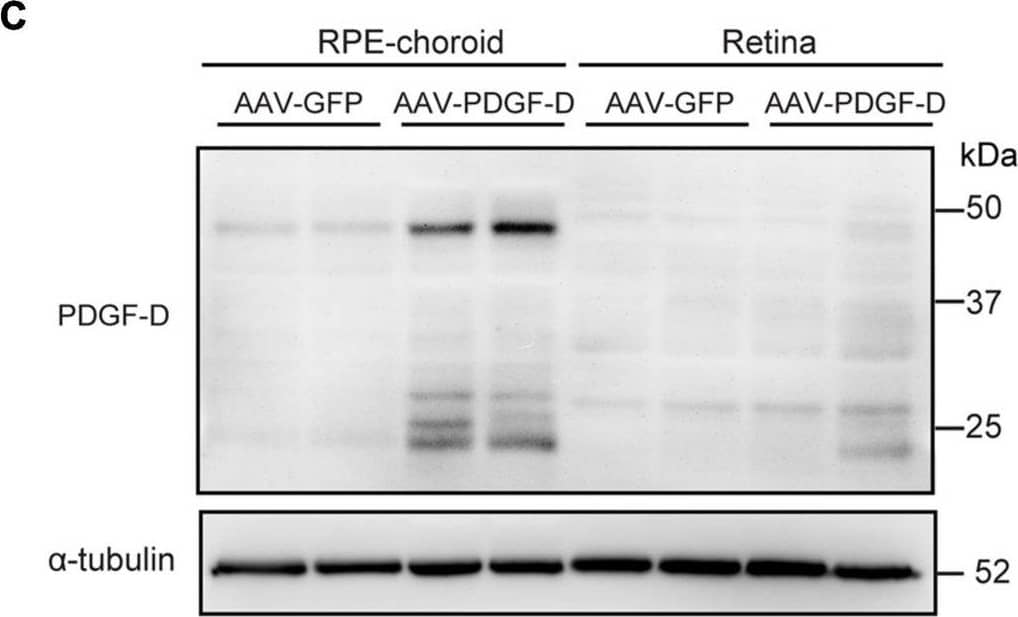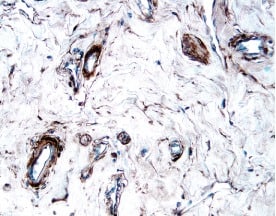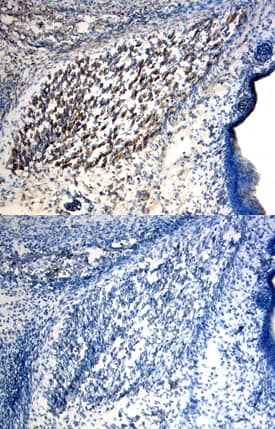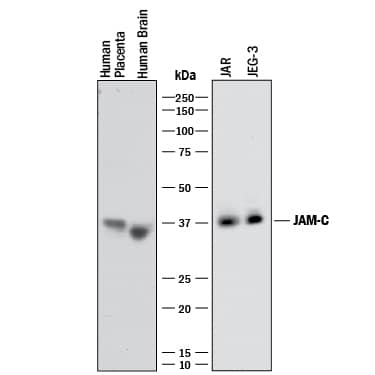Human PDGF-D Antibody Summary
Ser250-Arg370
Accession # Q9GZP0.1
Customers also Viewed
Applications
Please Note: Optimal dilutions should be determined by each laboratory for each application. General Protocols are available in the Technical Information section on our website.
Scientific Data
 View Larger
View Larger
Cell Proliferation Induced by PDGF‑DD and Neutralization by Human PDGF‑D Antibody. Recombinant Human PDGF-DD (Catalog # 1159-SB) stimulates proliferation in the NR6R-3T3 mouse fibroblast cell line in a dose-dependent manner (orange line). Proliferation elicited by Recombinant Human PDGF-DD (0.75 ug/mL) is neutralized (green line) by increasing concentrations of Mouse Anti-Human PDGF-D Monoclonal Antibody (Catalog # MAB1159). The ND50 is typically 1.5-7.5 µg/mL.
Preparation and Storage
- 12 months from date of receipt, -20 to -70 °C as supplied.
- 1 month, 2 to 8 °C under sterile conditions after reconstitution.
- 6 months, -20 to -70 °C under sterile conditions after reconstitution.
Background: PDGF-D
The platelet-derived growth factor (PDGF) family consists of four disulfide-linked homodimers and one heterodimer (PDGF-AB). These proteins regulate diverse cellular functions through interactions with PDGF R alpha and R beta (1, 2). Mature PDGF-DD associates with PDGF R beta and triggers signaling through PDGF R beta homodimers and PDGF R alpha / beta heterodimers (3‑5). The human PDGF-DD cDNA encodes a 370 amino acid (aa) precursor that includes a 23 aa signal sequence, one CUB domain, and one PDGF/VEGF domain (3, 4). The PDGF/VEGF domain shares 27‑35% aa sequence identity with the corresponding regions of other PDGF family members. Human PDGF-DD shares 87% aa sequence identity with mouse and rat PDGF-DD. PDGF-DD is secreted as a100 kDa latent homodimer which is activated by proteolysis to release a 35 kDa bioactive protein containing the PDGF/VEGF homology domain (3,4,6,7). A splice variant of PDGF-DD has a 6 aa deletion near the N-terminus. A 72 aa deletion within the PDGF/VEGF domain generates an inactive protein in mouse but has not been detected in human (8). PDGF-DD is widely expressed in embryonic and adult tissues (3, 9, 10), and PDGF R beta is expressed in a generally complementary pattern (9, 11, 12). PDGF-DD functions as a growth factor for renal artery smooth muscle cells and lens epithelial cells, and as a macrophage chemoattractant (5, 9‑11). PDGF-DD is overexpressed in and contributes to several disease states, including renal and hepatic fibrosis, mesangial proliferative glomerulopathy, pulmonary lymphoid infiltration, and many cancers (6, 11‑15). PDGF-DD functions in both paracrine and autocrine manners (6, 7, 14).
- Reigstad, L.J. et al. (2005) FEBS J. 272:5723.
- Fredriksson, L. et al. (2004) Cytokine Growth Factor Rev. 15:197.
- LaRochelle, W.J. et al. (2001) Nat. Cell Biol. 3:517.
- Bergsten, E. et al. (2001) Nat. Cell Biol. 3:512.
- Uutela, M. et al. (2004) Blood 104:3198.
- Ustach, C.V. and H-R.C. Kim (2005) Mol. Cell. Biol. 25:6279.
- Ustach, C.V. et al. (2004) Canc. Res. 64:1722.
- Zhuo, Y. et al. (2003) Biochem. Biophys. Res. Commun. 308:126.
- Changsirikulchai, S. et al. (2002) Kid. Int. 62:2043.
- Ray, S. et al. (2005) J. Biol. Chem. 280:8494.
- Hudkins, K.L. et al. (2004) J. Am. Soc. Nephrol. 15:286.
- Lokker, N.A. et al. (2002) Canc. Res. 62:3729.
- Taneda, S. et al. (2003) J. Am. Soc. Nephrol. 14:2544.
- LaRochelle, W.J. et al. (2002) Canc. Res. 62:2468.
- Xu, L. et al. (2005) Canc. Res. 65:5711.
Product Datasheets
Citations for Human PDGF-D Antibody
R&D Systems personnel manually curate a database that contains references using R&D Systems products. The data collected includes not only links to publications in PubMed, but also provides information about sample types, species, and experimental conditions.
2
Citations: Showing 1 - 2
Filter your results:
Filter by:
-
Phenotypic plasticity in normal breast derived epithelial cells.
Authors: Sauder C, Koziel J, Choi M, Fox M, Grimes B, Badve S, Blosser R, Radovich M, Lam C, Vaughan M, Herbert B, Clare S
BMC Cell Biol, 2014-06-10;15(0):20.
Species: Human
Sample Types: Whole Cells
Applications: ICC -
Therapeutic benefits of factors derived from stem cells from human exfoliated deciduous teeth for radiation-induced mouse xerostomia
Authors: F Kano, N Hashimoto, Y Liu, L Xia, T Nishihara, W Oki, K Kawarabaya, N Mizusawa, K Aota, T Sakai, M Azuma, H Hibi, T Iwasaki, T Iwamoto, N Horimai, A Yamamoto
Scientific Reports, 2023-02-15;13(1):2706.
FAQs
No product specific FAQs exist for this product, however you may
View all Antibody FAQsIsotype Controls
Reconstitution Buffers
Secondary Antibodies
Reviews for Human PDGF-D Antibody
There are currently no reviews for this product. Be the first to review Human PDGF-D Antibody and earn rewards!
Have you used Human PDGF-D Antibody?
Submit a review and receive an Amazon gift card.
$25/€18/£15/$25CAN/¥75 Yuan/¥2500 Yen for a review with an image
$10/€7/£6/$10 CAD/¥70 Yuan/¥1110 Yen for a review without an image

















